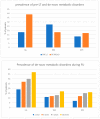Weight Gain and De Novo Metabolic Disorders after Liver Transplantation
- PMID: 31835505
- PMCID: PMC6950162
- DOI: 10.3390/nu11123015
Weight Gain and De Novo Metabolic Disorders after Liver Transplantation
Abstract
The development of nutritional and metabolic abnormalities represents an important burden in patients after liver transplantation (LT). Our study aimed at evaluating the incidence, time of onset, and risk factors for nutritional and metabolic abnormalities in patients after LT. The study was a single-center retrospective study. Consecutive patients undergoing elective LT from 2000 to 2016 were enrolled. The presence of at least two among arterial hypertension (AH), diabetes mellitus (DM), dyslipidemia, and obesity (BMI ≥ 30 Kg/m2) was utilized to define patients with the metabolic disorder (MD). Three hundred and fifteen patients were enrolled; the median age was 56 years (68% males). Non-alcoholic steatohepatitis (NASH) was the origin of liver disease in 10% of patients. During follow-up, 39% of patients developed AH, 18% DM, and 17% dyslipidemia. Metabolic disorders were observed in 32% of patients. The NASH etiology (OR: 6.2; CI 95% 0.5-3; p = 0.003) and a longer follow-up (OR: 1.2; CI 95% 0.004-0.02; p = 0.002) were associated with de novo MD. In conclusion, nutritional and metabolic disorders are a frequent complication after LT, being present in up to one-third of patients. The NASH etiology and a longer distance from LT are associated with de novo MD after LT.
Keywords: body mass index (BMI); liver transplantation (LT); metabolic disorders (MDs), non-alcoholic steatohepatitis (NASH).
Conflict of interest statement
The authors declare no conflict of interest.
Figures



References
-
- Wawrzynowicz-Syczewska M., Karpinska E., Jurczyk K., Laurans L., Boron-Kaczmarska A. Risk factors and dynamics of weight gain in patients after liver transplantation. Ann. Transpl. 2009;14:45–50. - PubMed
-
- Wong R.J., Aguilar M., Cheung R., Perumpail R.B., Harrison S.A., Younossi Z.M., Ahmed A. Nonalcoholic steatohepatitis is the second leading etiology of liver disease among adults awaiting liver transplantation in the United States. Gastroenterology. 2015;148:547–555. doi: 10.1053/j.gastro.2014.11.039. - DOI - PubMed
MeSH terms
LinkOut - more resources
Full Text Sources
Medical
Research Materials
Miscellaneous

